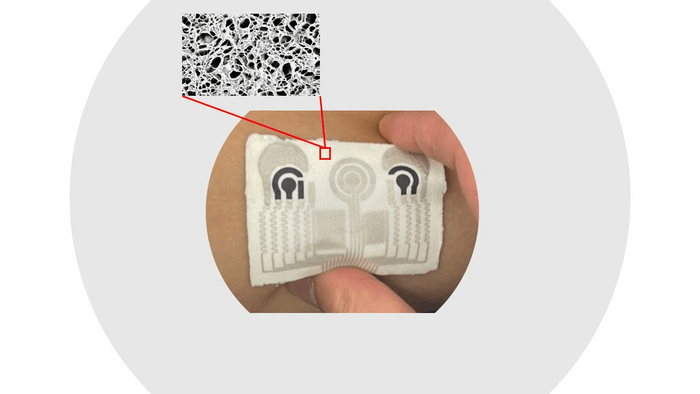(LOS ANGELES) – January 30, 2023 – Scientists from the Terasaki Institute for Biomedical Innovation (TIBI) have devised a first-of-its-kind electronic skin (E-skin) patch for advanced healthcare monitoring. With an optimum choice in materials coupled with a novel fabrication method, their unique E-skin patch provides simultaneous, continuous monitoring of multiple bodily parameters while also providing temperature-moisture management and breathability.
Electronic skin patches have been in use for some time to monitor bodily physiological and chemical indicators of health. These monitors, placed directly on the skin, can measure parameters such as body motions and temperature, skin hydration, various metabolic biomarkers, and brain and heart functionality (via electrocardiograms and electroencephalograms).
A typical skin-sensing patch consists of a sensor layer, which converts physical information into electrical signals, positioned on top of a flexible, stretchable substrate layer that is placed on the subject’s skin and is resistant to mechanical deformation.
Many of the current substrates, however, have mechanical and biological incompatibilities as well as poor breathability, which hamper multi-sensing ability and can result in skin irritation and inflammation, especially with long-term use. Moreover, most of the current substrates cannot be recycled or disposed of in an environmentally friendly way.
The TIBI researchers have addressed these problems by the development of a novel gelatin-based, highly porous substrate. By choosing to use gelatin methacryloyl (GelMA) to fabricate their substrate, they were able to meet the needs for biocompatibility, biodegradation, self-adhesion, and tissue-like mechanical properties. The need for breathability and moisture control, however, posed a challenge.
Although permeability can be achieved in GelMA by rendering it into a porous aerogel form, the resultant aerogel is brittle, making it unsuitable for skin-sensing substrates. The TIBI researchers have addressed this by carefully studying the effects of cryofreezing on GelMA flexibility and using this information to develop a novel method for overcoming the brittleness of GelMA aerogels.
The method enabled the creation of a GelMA aerogel that is flexible, breathable, ultralight, and moisture/air-permeable, due to its highly uniform and interconnected pores and their potential for three-dimensional capillary action.
The substrate’s enhanced capabilities also enabled the ability to screen-print integrated multifunctional sensors onto the substrate, which could then be placed on the skin to simultaneously stimulate sweat excretion and extraction of interstitial fluid just below the skin surface. This allows the continuous and multifunctional monitoring of such bodily parameters as skin temperature and hydration levels, electro-cardiac measurements, and metabolic markers such as glucose, alcohol, and lactic acid.
These functions were validated using the new E-skin patch in a series of tests measuring the effects of glucose and alcohol-containing diets on subjects performing strenuous exercise. When comparing the results against various individual commercial measurement devices, there was good correlation.
Further tests validated the new E-skin’s superior flexibility, thermal cooling abilities, and fluid absorption over conventional brittle aerogel substrates while demonstrating excellent biocompatibility and biodegradation without any skin irritation. Moreover, the E-skin is biodegradable, which eliminates the need for environmentally harmful waste disposal.
Such an innovative multi-sensing device would provide a more accurate, real-time patient physiological profile. This is especially beneficial for patients with several interrelated health conditions, such as those with insulin-dependent diabetes; these patients are prone to severe effects from glucose and alcohol and must closely monitor their consumption.
Usage of this E-skin can be expanded in other ways, such as by integrating additional simultaneous physiological measurements, coupling with drug delivery systems for therapeutic indications, and incorporating a wireless system for convenient use by patients.
“The advancements described here pave the way for producing next-generation electronic skin devices,” said Ali Khademhosseini, Ph.D., TIBI’s Director and CEO. “They will be valuable tools in healthcare management, offering the best in accurate, real-time monitoring for real-life situations.”
Authors are: Yangzhi Zhu, Reihaneh Haghniaz, Martin C. Hartel, Shenghan Guan, Jamal Bahari, Zijie Li, Avijit Baidya, Ke Cao, Xiaoxiang Gao, Jinghang Li, Zhuohong Wu, Xuanbing Cheng, Bingbing Li, Sam Emaminejad, Paul S. Weiss, and Ali Khademhosseini.
This work was supported in part by the National Institutes of Health (AR074234, UG3TR003148, GM126571, GM126831).
PRESS CONTACT
Stewart Han, shan@terasaki.org, +1 818-836-4393
Terasaki Institute for Biomedical Innovation
###
The Terasaki Institute for Biomedical Innovation (terasaki.org) is a non-profit research organization that invents and fosters practical solutions that restore or enhance the health of individuals. Research at the Terasaki Institute leverages scientific advancements that enable an understanding of what makes each person unique, from the macroscale of human tissues down to the microscale of genes, to create technological solutions for some of the most pressing medical problems of our time. We use innovative technology platforms to study human disease on the level of individual patients by incorporating advanced computational and tissue-engineering methods. Findings yielded by these studies are translated by our research teams into tailored diagnostic and therapeutic approaches encompassing personalized materials, cells and implants with unique potential and broad applicability to a variety of diseases, disorders, and injuries.
The Institute is made possible through an endowment from the late Dr. Paul I Terasaki, a pioneer in the field of organ transplant technology.
Journal
Advanced Materials
DOI
10.1002/adma.202209300
Method of Research
Experimental study
Subject of Research
Not applicable
Article Title
A Breathable, Passive-Cooling, Non-Inflammatory, and Biodegradable Aerogel Electronic Skin for Wearable Physical-Electrophysiological-Chemical Analysis
Article Publication Date
28-Dec-2022

















